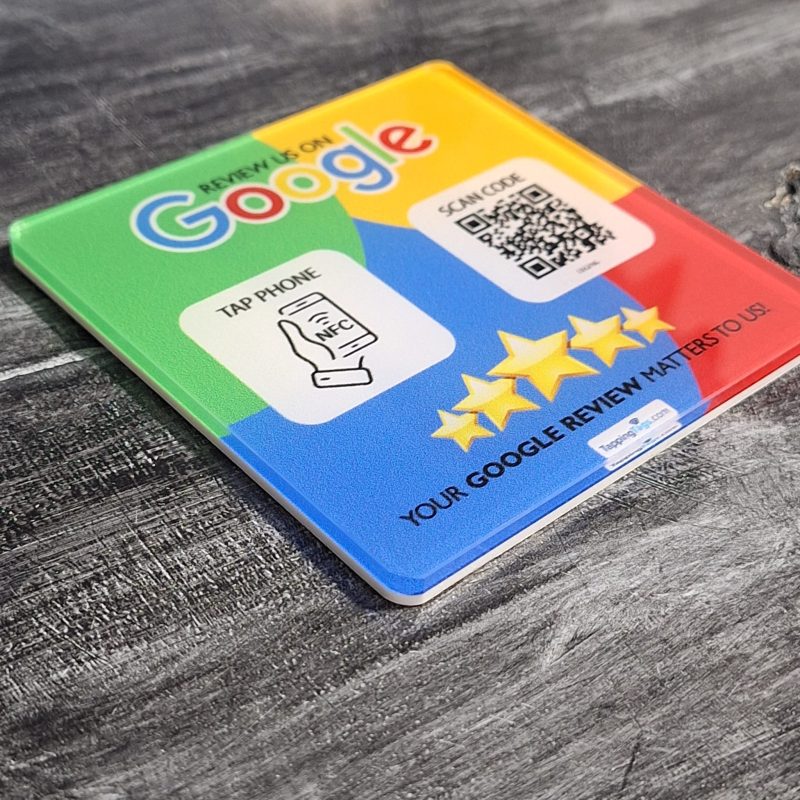Blog
How to Respond to Customer Reviews for Better Engagement
In today’s digital landscape, responding to customer reviews is more crucial than ever for enhancing engagement and building lasting relationships with your audience. At Revolutionizing Customer Feedback with NFC Technology, we understand the importance of effective communication in fostering customer loyalty. Our innovative company specializes in bridging the gap between customer engagement and technology, particularly through our flagship product, the Google Review NFC card. This cutting-edge tool leverages Near Field Communication (NFC) technology to simplify the process of collecting customer feedback, making it easier for businesses to connect with their clients. By mastering the art of responding to customer reviews, you can not only improve your online reputation but also encourage more customers to share their experiences. In this blog, we will explore practical strategies for responding to reviews that can lead to better engagement and ultimately drive your business forward.
Understanding the Importance of Customer Reviews

Customer reviews play a crucial role in shaping a business’s reputation and influencing potential customers. They provide valuable insights into customer experiences, helping businesses understand their strengths and areas for improvement. According to a study by BrightLocal, 87% of consumers read online reviews for local businesses, highlighting the significance of feedback in the decision-making process.
Engaging with customer reviews, both positive and negative, can foster a sense of community and trust. Responding to reviews shows customers that their opinions matter, which can lead to increased loyalty and repeat business. As noted by Harvard Business Review, "Responding to reviews can increase the likelihood of a customer returning by 30%."
Moreover, reviews can significantly impact search engine optimization (SEO). Search engines prioritize businesses with active engagement in their reviews, which can enhance visibility and attract more customers.
To effectively respond to customer reviews, consider the following strategies:
- Thank customers for their feedback, regardless of whether it is positive or negative.
- Address specific concerns raised in negative reviews to demonstrate your commitment to improvement.
- Encourage satisfied customers to leave reviews to build a robust online presence.
For more insights on enhancing customer engagement, visit our about page or explore our shop for tools that can help you manage customer feedback effectively.
Crafting Thoughtful Responses

Responding to customer reviews is an essential aspect of building a strong relationship with your audience. Crafting thoughtful responses not only shows that you value customer feedback but also enhances your brand’s reputation. When addressing reviews, whether positive or negative, it’s crucial to personalize your replies. Acknowledge the specific points raised by the customer, demonstrating that you have taken the time to read and understand their experience. This approach fosters a sense of connection and trust.
For positive reviews, express genuine gratitude and highlight how their feedback motivates your team. This not only encourages the reviewer to return but also attracts potential customers who read your responses. On the other hand, when dealing with negative feedback, remain calm and professional. Apologize for any inconvenience caused and offer a solution or invite the customer to discuss the matter further. This shows prospective customers that you are committed to resolving issues and improving your service.
Additionally, consider linking to relevant resources, such as your about page or your contact page, to provide customers with more information about your brand and how they can reach out for further assistance. By engaging thoughtfully with reviews, you not only enhance customer satisfaction but also create a positive online presence that can lead to increased loyalty and sales.
Personalizing Your Replies

When responding to customer reviews, personalization is key to fostering better engagement and building lasting relationships. Tailoring your replies to reflect the individual experiences of your customers not only shows that you value their feedback but also enhances your brand’s reputation. Start by addressing the reviewer by name, which creates a more personal connection. Acknowledge specific points they mentioned in their review, whether positive or negative, to demonstrate that you have genuinely considered their input.
For positive reviews, express gratitude and highlight how their feedback motivates your team. For constructive criticism, thank the reviewer for their insights and outline steps you are taking to address their concerns. This approach not only reassures the reviewer but also informs potential customers that you are committed to continuous improvement.
Additionally, consider incorporating a friendly tone and a touch of humor where appropriate, as this can make your responses more relatable. Encourage further interaction by inviting customers to reach out through your contact page or to explore more about your brand on the about page. By personalizing your replies, you create a welcoming atmosphere that encourages ongoing dialogue and enhances customer loyalty, ultimately leading to better engagement and a stronger community around your brand.
Addressing Negative Feedback Constructively
Responding to negative feedback is a crucial aspect of customer engagement that can significantly impact your brand’s reputation. When customers voice their concerns, it’s essential to approach their feedback with empathy and a willingness to resolve issues. Start by acknowledging the customer’s experience and expressing gratitude for their input. This shows that you value their opinion and are committed to improving your services.
Next, provide a thoughtful response that addresses the specific issues raised. Avoid generic replies; instead, personalize your message to demonstrate that you genuinely care about their concerns. If applicable, offer a solution or a way to rectify the situation, such as a refund, replacement, or additional support. This proactive approach not only helps to mend the relationship with the dissatisfied customer but also showcases your commitment to quality service to potential customers reading the review.
Additionally, invite the customer to discuss their experience further through private channels, such as email or phone. This not only helps to resolve the issue but also prevents further public negativity. By handling negative feedback constructively, you can turn a potentially damaging situation into an opportunity for growth and improvement. For more insights on enhancing customer relationships, visit our About page or explore our Shop for tools that can help streamline your customer engagement strategies.
Encouraging Further Engagement
Responding to customer reviews is not just about addressing feedback; it’s an opportunity to foster deeper connections with your audience. When you engage with customers who take the time to leave a review, whether positive or negative, you demonstrate that their opinions matter. This engagement can lead to increased customer loyalty and trust, as consumers appreciate brands that listen and respond.
To encourage further engagement, consider inviting customers to share more about their experiences. Ask open-ended questions in your responses, such as, “What did you enjoy most about your purchase?” or “How can we improve your experience next time?” This approach not only shows that you value their input but also encourages them to interact with your brand again.
Additionally, you can leverage social media platforms to continue the conversation. Share positive reviews on your social channels and tag the customers, inviting them to engage with your posts. This not only highlights your appreciation but also encourages others to leave their feedback.
For businesses looking to enhance their customer relationships, understanding the importance of engagement is crucial. Explore more about building connections through effective communication on our About page, or learn how to improve your customer service strategies by visiting our Shop. If you have any questions, feel free to reach out through our Contact Us page.
Utilizing Feedback for Business Improvement
In today’s competitive market, effectively responding to customer reviews is crucial for enhancing business performance. Customer feedback serves as a valuable resource for identifying strengths and weaknesses within your operations. By actively engaging with reviews, businesses can gain insights into customer preferences and expectations, allowing for targeted improvements.
When customers feel heard, their loyalty increases, leading to repeat business and positive word-of-mouth referrals. Acknowledging both positive and negative feedback demonstrates that you value customer opinions and are committed to continuous improvement. For instance, if a customer highlights a specific issue with your product or service, addressing it promptly can prevent future dissatisfaction and enhance overall customer experience.
Moreover, utilizing feedback can inform your marketing strategies and product development. By analyzing trends in customer reviews, you can identify popular features or common pain points, guiding your decisions on what to promote or improve. This proactive approach not only boosts customer satisfaction but also positions your business as responsive and customer-centric.
To learn more about how to effectively engage with your audience and improve your business, visit our about page. If you have any questions or need assistance, feel free to reach out through our contact page. For more resources, check out our shop for tools that can help enhance your customer engagement strategies.
Monitoring and Analyzing Review Trends
Understanding and tracking review trends is essential for businesses aiming to enhance customer engagement. By systematically monitoring customer feedback, companies can identify patterns in consumer sentiment, preferences, and areas needing improvement. This proactive approach allows businesses to respond effectively to reviews, whether they are positive or negative.
Analyzing review trends involves looking at various metrics, such as the frequency of reviews, common themes in customer feedback, and changes in ratings over time. Tools and software can assist in aggregating this data, making it easier to spot trends and shifts in customer perceptions. For instance, if a product consistently receives praise for its quality but criticism for its delivery time, businesses can address the shipping issues while promoting the product’s strengths.
Moreover, understanding these trends can inform marketing strategies and product development. By aligning offerings with customer expectations, businesses can foster loyalty and encourage repeat purchases. Engaging with customers through personalized responses based on their feedback not only shows that their opinions matter but also builds a community around the brand.
For more insights on enhancing customer interactions, visit our home page or learn more about our services. If you have any questions, feel free to contact us.
In conclusion, responding to customer reviews is not just a best practice; it’s a vital component of building a strong relationship with your audience. By actively engaging with both positive and negative feedback, you demonstrate that you value your customers’ opinions and are committed to improving their experience. Remember to personalize your responses, maintain a professional tone, and address specific concerns to foster trust and loyalty. As you cultivate this dialogue, you’ll not only enhance customer satisfaction but also encourage potential customers to choose your brand. Embrace the opportunity to turn reviews into meaningful interactions, and watch as your engagement and reputation flourish.
-
 Google Review NFC and QR Code Acrylic Stand
Rated 5.00 out of 5
Google Review NFC and QR Code Acrylic Stand
Rated 5.00 out of 5$75.00Original price was: $75.00.$38.50Current price is: $38.50. -
 Google Review NFC & QR Code Acrylic Tag with Sticker
Rated 5.00 out of 5
Google Review NFC & QR Code Acrylic Tag with Sticker
Rated 5.00 out of 5$49.00Original price was: $49.00.$27.00Current price is: $27.00. -
 Google Review NFC and QR Code Card - Tap or Scan
Rated 5.00 out of 5$18.90 – $98.90
Google Review NFC and QR Code Card - Tap or Scan
Rated 5.00 out of 5$18.90 – $98.90
